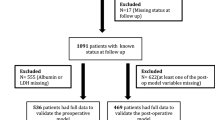Abstract
Purpose
To predict outcome of patients with renal cell carcinoma (RCC) who undergo surgical therapy, risk models and nomograms are valuable tools. External validation on independent datasets is crucial for evaluating accuracy and generalizability of these models. The objective of the present study was to externally validate the postoperative nomogram developed by Karakiewicz et al. for prediction of cancer-specific survival.
Methods
A total of 1,480 consecutive patients with a median follow-up of 82 months (IQR 46–128) were included into this analysis with 268 RCC-specific deaths. Nomogram-estimated survival probabilities were compared with survival probabilities of the actual cohort, and concordance indices were calculated. Calibration plots and decision curve analyses were used for evaluating calibration and clinical net benefit of the nomogram.
Results
Concordance between predictions of the nomogram and survival rates of the cohort was 0.911 after 12, 0.909 after 24 months and 0.896 after 60 months. Comparison of predicted probabilities and actual survival estimates with calibration plots showed an overestimation of tumor-specific survival based on nomogram predictions of high-risk patients, although calibration plots showed a reasonable calibration for probability ranges of interest. Decision curve analysis showed a positive net benefit of nomogram predictions for our patient cohort.
Conclusion
The postoperative Karakiewicz nomogram provides a good concordance in this external cohort and is reasonably calibrated. It may overestimate tumor-specific survival in high-risk patients, which should be kept in mind when counseling patients. A positive net benefit of nomogram predictions was proven.



Similar content being viewed by others
References
Siegel R, Naishadham D, Jemal A (2012) Cancer statistics, 2012. CA Cancer J Clin 62:10–29. doi:10.3322/caac.20138
Ljungberg B, Cowan NC, Hanbury DC et al (2010) EAU guidelines on renal cell carcinoma: the 2010 update. Eur Urol 58:398–406. doi:10.1016/j.eururo.2010.06.032
Hollingsworth JM, Miller DC, Daignault S, Hollenbeck BK (2007) Five-year survival after surgical treatment for kidney cancer: a population-based competing risk analysis. Cancer 109:1763–1768. doi:10.1002/cncr.22600
Volpe A, Patard J (2010) Prognostic factors in renal cell carcinoma. World J Urol 28:319–327
Galfano A, Novara G, Iafrate M et al (2008) Mathematical models for prognostic prediction in patients with renal cell carcinoma. Urol Int 80:113–123. doi:10.1159/000112599
Vickers AJ, Cronin AM, Elkin EB, Gonen M (2008) Extensions to decision curve analysis, a novel method for evaluating diagnostic tests, prediction models and molecular markers. BMC Med Inform Decis Mak 8:53. doi:10.1186/1472-6947-8-53
Karakiewicz PI, Briganti A, Chun FK-H et al (2007) Multi-institutional validation of a new renal cancer-specific survival nomogram. J Clin Oncol 25:1316–1322. doi:10.1200/JCO.2006.06.1218
Liu Z, Lv J, Ding K et al (2008) Validation of the current prognostic models for nonmetastatic renal cell carcinoma after nephrectomy in Chinese population: A 15-year single center experience. Int J Urol 16:268–273. doi:10.1111/j.1442-2042.2008.02229.x
Tan M-H, Li H, Choong CV et al (2011) The Karakiewicz nomogram is the most useful clinical predictor for survival outcomes in patients with localized renal cell carcinoma. Cancer 117:5314–5324. doi:10.1002/cncr.26193
Cindolo L, Chiodini P, Brookman-May S et al (2013) Assessing the accuracy and generalizability of the preoperative and postoperative Karakiewicz nomograms for renal cell carcinoma: results from a multicentre European and US study. BJU Int 112:578–584. doi:10.1111/j.1464-410X.2012.11670.x
Greene FL, Cancer AJCO, Society AC (2002) AJCC Cancer Staging Manual. Springer, London
Sobin L, Gospodarowicz M, Wittekind C (2010) TNM classification of malignant tumors, 7 ed. UICC International Union Against Cancer
Fuhrman SA, Lasky LC, Limas C (1982) Prognostic significance of morphologic parameters in renal cell carcinoma. Am J Surg Pathol 6:655–663
Kovacs G, Akhtar M, Beckwith BJ, et al. (1997) The Heidelberg classification of renal cell tumours. J Pathol 183:131–133. doi:10.1002/(SICI)1096-9896(199710)183:2<131::AID-PATH931>3.0.CO;2-G
Harrell FE (2001) Regression modeling strategies: with applications to linear models, logistic regression and survival analysis, 2nd edn. Springer, Berlin
Meskawi M, Sun M, Trinh Q-D et al (2012) A review of integrated staging systems for renal cell carcinoma. Eur Urol 62:303–314. doi:10.1016/j.eururo.2012.04.049
Kattan MW, Reuter V, Motzer RJ et al (2001) A postoperative prognostic nomogram for renal cell carcinoma. J Urol 166:63–67
Sorbellini M, Kattan MW, Snyder ME et al (2005) A postoperative prognostic nomogram predicting recurrence for patients with conventional clear cell renal cell carcinoma. J Urol 173:48–51. doi:10.1097/01.ju.0000148261.19532.2c
Leibovich BC, Blute ML, Cheville JC et al (2003) Prediction of progression after radical nephrectomy for patients with clear cell renal cell carcinoma: a stratification tool for prospective clinical trials. Cancer 97:1663–1671. doi:10.1002/cncr.11234
Brookman-May S, May M, Shariat SF et al (2012) Features associated with recurrence beyond 5 years after nephrectomy and nephron-sparing surgery for renal cell carcinoma: development and internal validation of a risk model (PRELANE score) to predict late recurrence based on a large multicenter database (CORONA/SATURN project). Eur Urol 1–6. doi:10.1016/j.eururo.2012.06.030
Novara G, Ficarra V, Antonelli A et al (2010) Validation of the 2009 TNM version in a large multi-institutional cohort of patients treated for renal cell carcinoma: are further improvements needed? Eur Urol 58:588–595. doi:10.1016/j.eururo.2010.07.006
Novara G, Martignoni G, Artibani W, Ficarra V (2007) Grading systems in renal cell carcinoma. J Urol 177:430–436
Conflict of interest
The authors declare that there is no conflict of interest.
Ethical standard
The authors declare that the study has been approved by the appropriate ethics committee.
Author information
Authors and Affiliations
Corresponding author
Rights and permissions
About this article
Cite this article
Zastrow, S., Brookman-May, S., Cong, T.A.P. et al. Decision curve analysis and external validation of the postoperative Karakiewicz nomogram for renal cell carcinoma based on a large single-center study cohort. World J Urol 33, 381–388 (2015). https://doi.org/10.1007/s00345-014-1321-6
Received:
Accepted:
Published:
Issue Date:
DOI: https://doi.org/10.1007/s00345-014-1321-6




